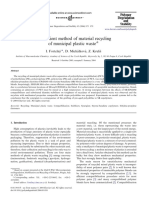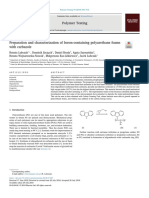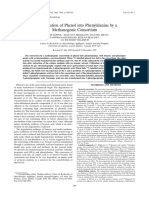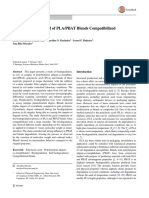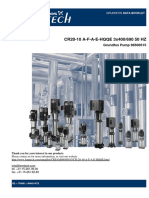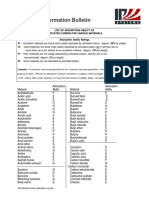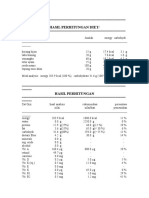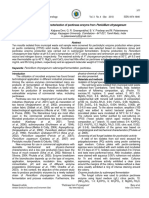Journal of Physical Science, Vol. 19(2), 105–115, 2008 105
Synthesis of Degradable Bio-Composites Based on Recycle Polypropylene Filled with Bamboo Powder Using a Reactive Process
Neng Sri Suharty
1*
, Basuki Wirjosentono
2
, Maulidan Firdaus
1
, Desi S. Handayani
1
, Jamilatus Sholikhah
1
and Yuniarni A. Maharani
1
1
Department of Chemistry, Faculty of Mathematics and Natural Sciences, Sebelas Maret University, Jl. Ir Sutami 36A Surakarta, Indonesia
2
Department of Chemistry, Faculty of Mathematics and Natural Sciences, University of North Sumatera, Jl. Bioteknologi 1 Padang Bulan Medan, Indonesia *Corresponding author: nengsuharty@yahoo.com
Abstract:
Synthesis of bio-composite from recycled polypropylene (rPP) using bamboo powder (BP) as a filler had been carried out. Five levels of filler loading with or without divinyl benzene (DVB) were designed. The influence of filler concentration could improve tensile strength (TS) up to the optimum condition (ratio rPP/BP = 8/2). The effect of the bamboo particle size showed that the TS increased as the size of the particle smaller. The effect of BP particle size showed that the bigger of its size gave better bio-degradation properties. The use of DVB for the synthesis of bio-composites showed more biodegradable than without DVB.
Keywords
: biodegradable, bio-composites, recycled polypropylene, bamboo powder
1. INTRODUCTION
Polypropylene (PP) is generally utilized as packaging materials and has a great potential to become waste when it is not used anymore. This PP waste can be used to other useful product and will not contaminate the environment. This PP waste (referred as recycled PP, rPP) has functional group >CH- (methine) which is capable to react with other functional group.
1
As a tropical plant, bamboo grows easily in Indonesia. Part of the bamboo which commonly used is its bar.
2
Bamboo bar mainly consists of cellulose, besides hemicellulose and lignin. Cellulose has three polar free hydroxyl groups and two glycoside carbon groups.
3,4
In this research, BP has been utilized as a filler material for the synthesis of biodegradable bio-composite.
5,6
Both rPP and BP have functional group which are different in its polarity. This means that it is difficult to bind one another directly.
1
On the other hand, rPP has non polar methine group. To bind between cellulose and PP, it needs to modify using acrylic acid (AA) as multifunctional, owning non polar vinyl group and polar carboxylic group.
7
The use of AA as a modifier will realize the formation of bio-composite. The methine group of rPP will bind with the
Synthesis of Degradable Bio-Composites 106
vinyl group of AA and the carboxylic group of AA will react with hydroxyl group from cellulose to form ester.
3,7
To improve the binding properties, DVB was used as crosslinker agent.
8
The utilization of bamboo as a filler can improve not only the mechanical properties of bio-composite but also the character of its biodegradability. In order to prove the nature of its biodegradability, the bio-composites were technically buried in garbage dump land which consist of cellulolytic bacteria.
7,9
Monitoring were done periodically every one month with measuring the change of its weight caused by natural degradable process.
2. MATERIALS AND METHODS 2.1
General Information
All starting compounds were purchased from E. Merck and used as such without any further purification. The rPP was obtained from drinking water cup waste. BP were obtained from crafting industry from Yogyakarta, Indonesia. Melt flow indexer, Atlas was used to determine the melt flow index (MFI) of bio-composite. A hot press model Paul Weber Machinen-u-Aparatebau D-7064 Rhemshalden-Brunbach was utilized to prepare specimens. Tensometry (MPG SC-2 DE) was done to determine TS. FTIR (Shimadzhu FTIR-8201 PC) with a potassium bromide (KBr) disks or films was conducted to determine the functional groups of compounds. Differential Thermal Analysis (DTA) was performed to determine decomposition profile of bio-composite. Morphological analysis was done using scanning electron microscope (SEM) JSM-35C.
2.2
Preparation of rPP and BP
rPP samples after washed with ethanol, finally were chopped in 2 x 2 mm size. BP were firstly cleaned with ethanol, then dried in the oven of 40
o
C and grinding until 80 and 150 mesh.
7
2.3
Synthesis of PP Bio-Composites Using Filler BP Fibre
The synthesis of PP bio-composites was conducted by solution process (in total 50 g starting material) using xylene as solvent which was capable to dissolve rPP. The synthesis of bio-composites was reactively processed using benzoyl peroxide, BPO initiator. Xylene 300 ml, rPP in varying weight and BPO were placed in a 500 ml round bottomed flask equipped with a mechanical stirrer, thermometer and condenser for reactive process. The mixture was stirred for one hour and followed by AA and BP addition. The mixture was then refluxed at 135
o
C for 3 h until the solution homogenous. The mixture composition of process
Journal of Physical Science, Vol. 19(2), 105–115, 2008 107
were as follow: BPO 0.08% of total weight, 10% AA to BP weight, and variation of rPP/BP in weight ratio: 10/0, 9/1, 8/2, 7/3 and 6/4, the particle size of BP were 80 and 150 mesh without or with DVB crosslinker agent (5% from AA). Furthermore, the resulting composite mixture was evaporated to remove the xylene solvent. The resulting bio-composites from the reactive process were referred as rPP/AA/BP and rPP/DVB/AA/BP. The flow behavior of the bio-composites was then determined their MFI value.
7
Preparation of the bio-composites specimens were done using hot press. The specimens were measured their TS according to ASTM D638-97 by means of interesting test to every bio-composites specimen using tensometry. The functional groups of compounds were characterized by FTIR. The profiles of degradation and decomposition of compounds were analyzed by DTA.
Morphological analysis of bio-composite specimens
was done using SEM
(
in 2500x magnification).
3. RESULT AND DISCUSSION 3.1 Characterization of Functional Groups of Starting Materials: rPP, AA, DVB and BP
Each starting material compound used for the synthesis of bio-composite was spectroscopically characterized by FTIR (Fig. 1). The FTIR spectrum of pure AA in neat liquid shows the absorption at 1728 cm
–1
( >C=O carbonyl group), 1636 and 1412 cm
–1
(-HC=CH
2
for acrylic double bond), 2978 and 987 cm
–1
indicate > CH- (methine) group of AA. The FTIR spectrum of pure DVB shows the absorption at 1631 and 1400 cm
–1
( >C=CH
2
for DVB double bond). The FTIR spectrum of rPP film shows absorption at 2890 and 999 cm
–1
refer to >CH- (methine) group of PP; absorption at 2723 cm
–1
(C-H stretching typical of PP); absorption at 2890 and 1454 cm
–1
refer to -CH
2
- (methylene); absorption at 2890 and 1373 cm
–1
express the existence of -CH
3
and absorption at 1639 cm
–1
as an impurities. The FTIR spectrum of BP in KBr pellets shows broad absorption at 3447 cm
–1
from -OH cellulose hydrogen bonding; absorption at 2924 and 1458 cm
–1
(-CH
2
-); absorption at 1651 cm
–1
( >C=C< aromatic of lignin in BP) and absorption at 1049 cm
–1
(-C-O-C- of cellulose).
8,10,11
Synthesis of Degradable Bio-Composites 108
Figure 1: FTIR spectrum of starting materials: rPP, AA, BP and DVB.
3.2
Characterizations of Bio-Composite’s Functional Groups
The formed bio-composite was then analyzed on its functional group. This result compared to the character of each its starting materials as shown in Figure 2. The spectrum of bio-composite rPP/DVB/AA/BP shows absorption at 3348 cm
–1
(broad) from -OH cellulose hydrogen bonding; 2723 cm
–1
typical of PP; 2843, 1450, 1377 and 999 cm
–1
from methine, methylene and methyl groups; 1732 cm
–1
from carbonyl ester group and 1639 cm
–1
impurities of PP. A shift in AA carbonyl group from 1728 cm
–1
to 1732 cm
–1
is caused by esterification between hydroxyl cellulose and carboxylic group of AA, it means that between polar hydroxyl group of BP and polar hydroxyl carboxylic group of AA had reacted. The disappearance of the vinyl group of AA at 1636 and 1412 cm
–1
, and the vinyl group of DVB at 1631 and 1400 cm
–1
is due to those non polar double bond of vinyl that bound with non polar methine group of PP forming the bio-composite.
7,8,10–12
3.3
Characterization of Bio-Composite’s Mechanical Properties
Parameters used to determine the optimum condition process were referred to the best TS property of bio-composite. From some variation ratio of rPP/BP, it was shown that the highest value of TS either rPP/AA/BP or rPP/DVB/AA/BP was 8/2 (as shown in Figs. 3 & 4). In the next discussion, this











